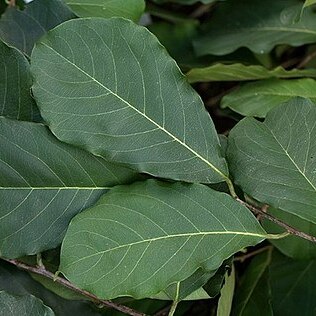Leaves subcoriaceous, drying pale brown with pale yellow nerves above and beneath; lamina 5·5 x 3–11 x 6·5 cm., obovate; apex shortly cuspidate; lower surface densely setulose on midrib, sparsely so elsewhere; secondary nerves in 6–9 pairs, prominent beneath, tertiary nerves subscalariform, venation closely reticulate, slightly prominent above, more so beneath.
A shrub or tree. It grows 30-9 m high. The trunk is slender. The bark is black and flaking. The leaves are dark green. They are broadly oval. It loses its leaves during the year. The flowers are white. They are in the axils of leaves. They have a scent. The fruit are round and 2 cm across. They are yellow and slightly hairy.
Male flowers in (1) 3(7)–flowered lax cymules borne towards the base of the current year’s shoot in the axils of caducous reduced leaves and the first–formed foliage leaves; peduncle c. 0·6 cm. long; pedicels 0·1–0·3 cm. long, fulvous–tomentellous.
Stamens 24–28, 0·4–0·5 cm. long; filaments 0·1–0·15 cm. long, glabrous, inserted singly or in pairs on corolla–tube; anthers linear–lanceolate, apiculate, glabrous or strigulose.
Ovary 0·25 x 0·25 cm., subglobose; locules 8 or 10, uniovulate; styles 4(5), as long as ovary, ascending, expanded distally, fleshy and stigmatic on inner surface.
Staminodes 4, inserted on corolla–tube and alternating with the lobes, 0·2 cm. long, completely glabrous except for a single apical seta.
Fruiting calyx slightly accrescent, c. 1·2 cm. long, lobes 0·8 x 0·6 cm., reflexed, with conspicuous, ± flabellate, longitudinal veins.
Corolla 0·7 cm. long, subrotate, strigulose on mid–petaline lines, otherwise glabrous; tube 0·15 cm. long; lobes 4, ovate–lingulate.
Calyx 0·25 cm. long, strigulose–tomentellous outside, glabrous inside, 4–lobed to about the middle; lobes suborbicular.
Seeds 8 or 10 or fewer by abortion, dark brown, 1·2 x 0·6 x 0·5 cm., surface wrinkled, endosperm ruminate.
Calyx as in male but 0·6 cm. long and more deeply–lobed; lobes markedly imbricate.
Small deciduous tree 3–9 m. high, sometimes flowering as a shrub c. 2 m. high.
Bark grey or brown, with close and shallow longitudinal fissures.
Female flowers solitary, borne as in male; pedicel 0·4 cm. long.
Pistillode 0·1 x 0·1 cm., sparsely setulose.
Corolla as in male but 0·7–0·85 cm. long.
Fruit c. 2 x 2 cm., subglobose, glabrous.


